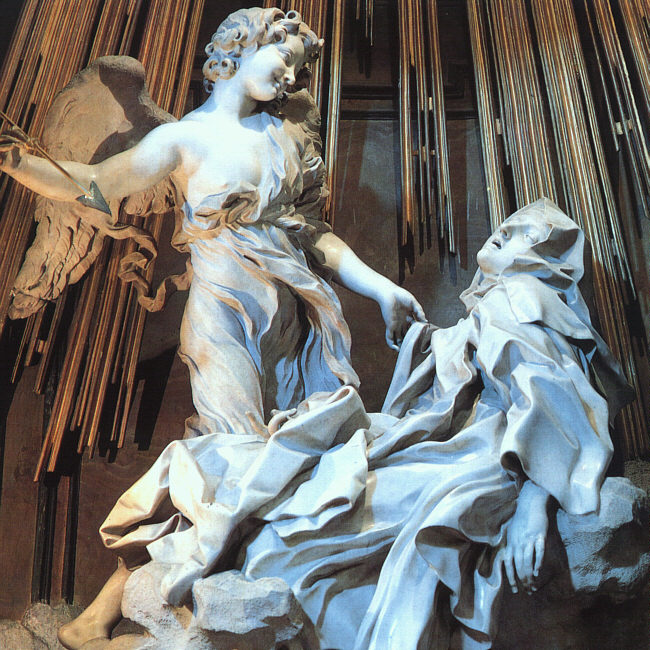Joseph Adler
Religious Studies 482
COMPARATIVE MYSTICISM
|
Fall 2003 |
||
|
Ascension 312 |
Wed. eve, 7:30-10:00 pm |
|
|
E-mail adlerj@kenyon.edu |
202 W. Brooklyn St. |
|
|
Tel. 427-5290 |
Office hours: M 3-4, TTh 2-4 |
|
|
and by appointment |
This seminar will explore the religious phenomenon and category of
"mysticism" in a variety of traditions, including Judaism, Christianity,
Taoism, and Buddhism. We will read some of the seminal works that helped
define "mysticism" as a particular form of religious experience,
including William James, Evelyn Underhill, and Walter Stace. Then we will
examine a selection of mystical texts from the various traditions. Finally
we will focus on the methodological and philosophical problems involved
in interpreting mystical experience in cross-cultural perspective. Particular
questions to be addressed include: the nature of mystical experience and
religious experience in general, the relationship between religious experience
and other aspects of religious traditions, the question of the universality
of mystical experience, and the nature and purpose of the academic study
of religion itself. Prerequisite: Any 100-level course AND any 200-level
course in Religious Studies.
Reading:
Available in Bookstore
Dan Cohn-Sherbok, Jewish Mysticism: An Anthology
Kieran Kavanaugh and Otilio Rodriguez, trans., Teresa of Avila:
The Interior Castle
Burton Watson, trans., Chuang Tzu: Basic Writings
Steven T. Katz, ed., Mysticism and Philosophical Analysis
Robert K.C. Forman, ed., The Problem of Pure Consciousness
On Course Reserve
Robert S. Ellwood, Mysticism and Religion, 2nd ed.
Ninian Smart, Dimensions of the Sacred
William James, Varieties of Religious Experience
Steven T. Katz, ed., Mysticism and Religious Traditions
Victor Mair, Experimental Essays on Chuang Tzu
Journal of the American Academy of Religion, vols. 55, 56
Steven T. Katz, ed., Comparative Mysticism: An Anthology of Original
Sources
(if and when it is received by the library)
Course requirements and grading
- Participation (20% of grade). The seminar format requires regular attendance, completion of reading assignments, and active participation in discussion by all members. Necessary absences must be cleared in advance with the instructor; unexcused absences will result in a grade penalty.
- Nine 2-4 page response papers (6% each). These should be critical
responses to the week's readings (not summaries).
- Research paper (20%) and oral report on your research
(6%). The paper will be 12-15 pages in length (plus bibliography), on
any subject related to the course, using at least two books or articles
outside of assigned reading. The topic and preliminary bibliography
must be discussed with me by Wednesday, Nov 5. The oral reports will
be given during the last two weeks of seminar. The paper will be due
by Friday, Dec. 19.
 |
"Beside me on the left appeared an angel in bodily form . . . He was not tall but short, and very beautiful; and his face was so aflame that he appeared to be one of the highest ranks of angels, who seem to be all on fire . . . In his hands I saw a great golden spear, and at the iron tip there appeared to be a point of fire. This he plunged into my heart several times so that it penetrated my entrails. When he pulled it out I felt that he took them with it, and left me utterly consumed by the great love of God. The pain was so severe that it made me utter several moans. The sweetness caused by this intense pain is so extreme that one can not possibly wish it to cease, nor is one's soul content with anything but God. This is not a physical but a spiritual pain, though the body has some share in it -- even a considerable share." (Teresa of Avila, Autobiography, ch. 29). |
|
in Santa Maria della Vittoria, Rome. Marble, 11' 6" high. |
Seminar Schedule
| 1 | Sep 3 | What is mysticism? |
| Read: |
|
| 2 | Sep 10 | Some classical theories of mysticism |
| Read: |
|
| 3 | Sep 17 | Mysticism
as a form of religious experience; Neo-Platonism |
| Read: |
|
| 4 | Sep 24 | Jewish mysticism |
| Read: |
|
| 5 | Oct 1 | Christian mysticism |
| Read: |
|
| 6 | Oct 8 | Taoist mysticism |
| Read: |
|
<< October break >>
| 7 | Oct 15 | Hindu mysticism |
| Read: |
|
| 8 | Oct 22 | Buddhist mysticism |
| Read: |
|
| 9 | Oct 29 | "Constructivist" theory (1) |
| Read: |
|
| 10 | Nov 5 | "Constructivist" theory (2) |
| Read: |
|
| 11 | Nov 12 | "Perennialist" theory (1) |
| Read: |
|
| 12 | Nov 19 | "Perennialist" theory (2) |
| Read: |
|
<< Thanksgiving break >>
| 13 | Dec 3 | Research presentations |
| 14 | Dec 10 | Research presentations |